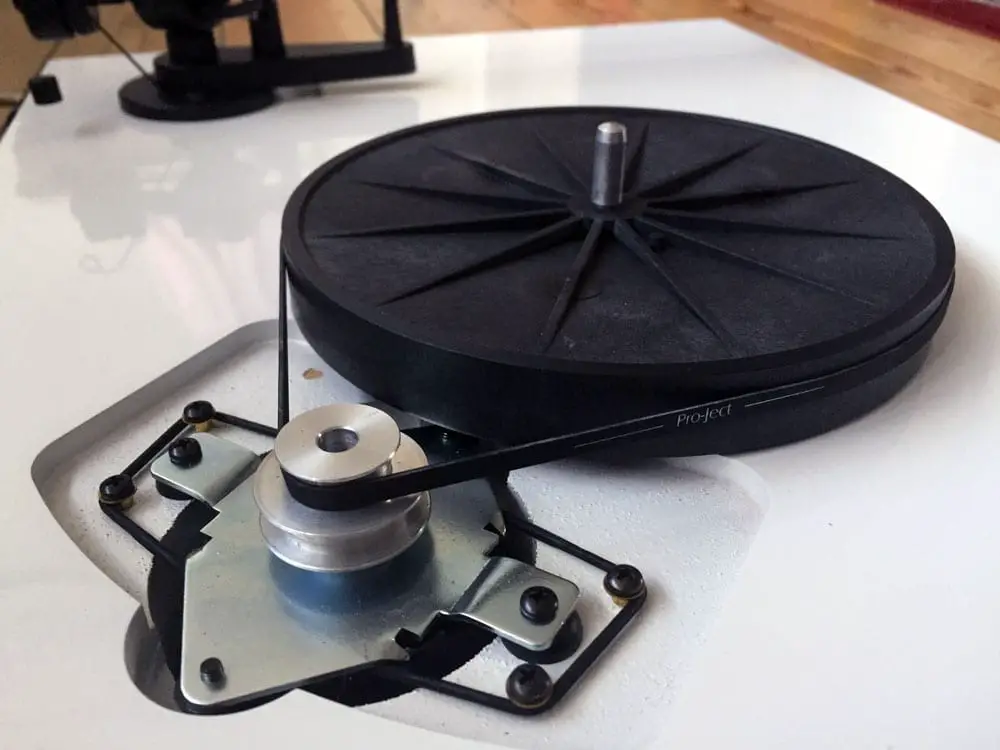When buying your first turntable, or even upgrading your current setup, there are many technical terms and details that cause some confusion for would-be vinyl enthusiasts. At Sound Matters, we present answers to many of these frequently asked questions in a way that cuts through the jargon, getting to the key points you need to know. Today, we tackle the differences between direct-drive and belt-driven turntable designs.

So what’s the deal?
The key difference is how the motor drives the record platter. A belt-driven turntable uses a belt to move the platter. The motor that drives the belt is positioned off to the side. In the case of direct-drive designs, the platter sits directly on the motor.
Which design is best? Direct-drive or belt-drive?
As with most questions of this kind, it very much depends on a number of different factors. One is not better than the other as such, they simply have pros and cons.
DJ’s will almost invariably opt for direct-drive for a number of reasons. For one, the turntable can get up to speed much quicker (almost instantly). The higher torque also means the patter can spin in either direction without any risk of damage to the turntable motor. In addition, direct-drive turntables give the user greater control over speed, with many models coming equipt with a variable speed pitch control—allowing the user to deviate from a standard speed (such as 33 or 45 rpm).
All of these benefits allow DJ’s to use the turntable like an instrument, quickly stopping and starting records, scratching, cueing up tracks, and varying speed to create transitions from one track to another. In short, the greater control makes direct-drive an obvious choice for turntablists and DJ’s.
If you’re not a DJ and you simply want to listen to vinyl records, then a belt-drive turntable might be the better option. Mounting the platter directly to the motor might give greater control, but it also introduces a greater amount of noise interference that can work its way into the playback system. A belt-driven turntable isolates the motor from the platters, with just the rubber belt connecting the two components. On some turntables, the belt is clearly visible and wrapped around the outside of the platter. Other designs conceal the belt underneath the platter. The belt in itself helps to absorb shock and vibration from the motor, resulting in quieter playback. The best designs also isolate the motor from the turntable itself, further reducing the risk of vibration interference.
A Matter of Speed
Speed consistency is often considered the downside of belt-drive. They’re reliant on more moving parts, which inherently makes them more prone to speed changes. For example, if the belt is worn, or the flywheel is damaged or isn’t machined properly, the speed will certainly be affected.
The quartz locking systems commonly found in direct-drive turntables control the speed using a quartz crystal clock. These systems compare the speed of the platter to the oscillating frequency of the quartz crystal and adjust the platter speed accordingly.
It is possible to improve the speed consistency of a belt-drive system by adding a speed regulator to the power supply. Take this example from Pro-Ject. The Speed Box S2 applies quartz-generated speed regulation to improve performance on many of their turntable range. You may also find that a heavier platter helps to keep the speed from varying.
The bottom line
A well-designed and manufactured belt-drive turntable remains the de facto choice for Hi-Fi audio enthusiasts, while direct-drive offers the level of control and durability desired for turntablism. But that is not to say there aren’t some great sounding direct-drive turntables on the market. It’s not a hard and fast rule, simply a guide based on the pros and cons of each. The best way to choose the right design for you is simply to use your ears. If it sounds good, it is good.




[…] choosing a turntable. It determines the use and performance you are seeking for your machine. The Drive Systems of the turntables in our list are either belt-drive and the […]
[…] results in better performance across the board. These systems get up to the right playing speed much faster and stay […]
Interesting precis . Having experienced both types at comparable low/ mid prices I found direct drive to be reliably more ‘hifi. ‘ . At higher price levels the refined belt drive wins with lower noise. However the newish Technics models are superb with the torque ensuring clearer soundstaging thro the frequency ranges and tidying the messiest cuts. The Fact is that models of both types vary in repro. and their responses to varying arms/ cartridges and supports. It’s tricky- even for experienced reviewers to judge and make general unbiased assertions when the purchasing listeners ears and perception is also so very variable. It’s a fascinating hobby .